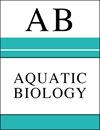One year of warming leads to the total loss of productivity in a widespread photosymbiosis
IF 0.8
4区 生物学
Q3 MARINE & FRESHWATER BIOLOGY
引用次数: 0
Abstract
ABSTRACT: Photosymbioses, in which photosynthetic microorganisms reside within heterotrophic hosts, are important components of aquatic ecosystems and are under threat from environmental warming. The immediate ecological consequences of acute warming for archetypal photosymbioses, such as those between corals and zooxanthellae, are well documented. In contrast, understanding of the evolutionary responses of photosymbioses to persistent warming remains limited and direct observations of evolution in response to warming are scarce, as many associations are slow-evolving and do not enable observations on a tractable timescale. To address this knowledge gap, we exposed the widespread microbial Paramecium bursaria-Chlorella spp. photosymbiosis to 295 d of continuous growth under +5°°C of persistent warming. We subsequently quantified the thermal responses of traits associated with symbiosis persistence and ecological function (growth rate, symbiont density [the number of symbionts within hosts], and metabolic rates) compared with cultures maintained at ambient temperature and cultures exposed to -5°°C of cooling for the same time period. Strikingly, while growth rate thermal optimum increased with warming, net photosynthesis and carbon-use efficiency (the proportion of photosynthetic carbon available for growth) both strongly declined to zero. These data suggest a significant change in ecological function with persistent warming. We also detected larger autonomous symbiont populations following 295 d of warming, and symbionts from the warm-adapted symbiosis demonstrated a ‘switch’ from exclusive growth on organic to inorganic nitrogen, suggesting that symbionts could have evolved increased autonomy from hosts. Thus, warming could erode the ecological function and promote symbiont autonomy in photosymbiosis over evolutionary timescales.一年的气候变暖导致大范围光合共生中生产力的完全丧失
摘要:光合共生(光合微生物寄居在异养生物宿主体内)是水生生态系统的重要组成部分,正受到环境变暖的威胁。气候急剧变暖对典型光合共生现象(如珊瑚与动物贝类之间的共生现象)造成的直接生态后果已有详细记载。相比之下,人们对光合共生体对持续变暖的进化反应的了解仍然有限,而且由于许多共生关系进化缓慢,无法在可控的时间尺度上进行观测,因此直接观测光合共生体对气候变暖的进化反应的机会很少。为了填补这一知识空白,我们将广泛存在的微生物法氏囊伞菌-小球藻光合共生置于+5°°C的持续变暖条件下,持续生长295天。随后,我们对与共生持续性和生态功能(生长速率、共生体密度[宿主体内共生体的数量]和代谢率)相关的性状的热反应进行了量化,并与在环境温度下维持的培养物和在同一时期暴露于-5°°C降温条件下的培养物进行了比较。令人吃惊的是,虽然生长率热最适值随着气候变暖而增加,但净光合作用和碳利用效率(可用于生长的光合作用碳的比例)均大幅下降至零。这些数据表明,随着气候持续变暖,生态功能发生了重大变化。在气候变暖 295 天后,我们还检测到了更大的自主共生体种群,来自暖适应共生体的共生体表现出了从完全依靠有机氮生长到依靠无机氮生长的 "转换",这表明共生体可能已经从宿主那里进化出了更大的自主性。因此,在进化过程中,气候变暖可能会侵蚀光合共生的生态功能,促进共生体的自主性。
本文章由计算机程序翻译,如有差异,请以英文原文为准。
求助全文
约1分钟内获得全文
求助全文
来源期刊

Aquatic Biology
生物-海洋与淡水生物学
CiteScore
2.70
自引率
0.00%
发文量
7
审稿时长
3 months
期刊介绍:
AB publishes rigorously refereed and carefully selected Feature Articles, Research Articles, Reviews and Notes, as well as Comments/Reply Comments (for details see MEPS 228:1), Theme Sections, Opinion Pieces (previously called ''As I See It'') (for details consult the Guidelines for Authors) concerned with the biology, physiology, biochemistry and genetics (including the ’omics‘) of all aquatic organisms under laboratory and field conditions, and at all levels of organisation and investigation. Areas covered include:
-Biological aspects of biota: Evolution and speciation; life histories; biodiversity, biogeography and phylogeography; population genetics; biological connectedness between marine and freshwater biota; paleobiology of aquatic environments; invasive species.
-Biochemical and physiological aspects of aquatic life; synthesis and conversion of organic matter (mechanisms of auto- and heterotrophy, digestion, respiration, nutrition); thermo-, ion, osmo- and volume-regulation; stress and stress resistance; metabolism and energy budgets; non-genetic and genetic adaptation.
-Species interactions: Environment–organism and organism–organism interrelationships; predation: defenses (physical and chemical); symbioses.
-Molecular biology of aquatic life.
-Behavior: Orientation in space and time; migrations; feeding and reproductive behavior; agonistic behavior.
-Toxicology and water-quality effects on organisms; anthropogenic impacts on aquatic biota (e.g. pollution, fisheries); stream regulation and restoration.
-Theoretical biology: mathematical modelling of biological processes and species interactions.
-Methodology and equipment employed in aquatic biological research; underwater exploration and experimentation.
-Exploitation of aquatic biota: Fisheries; cultivation of aquatic organisms: use, management, protection and conservation of living aquatic resources.
-Reproduction and development in marine, brackish and freshwater organisms
 求助内容:
求助内容: 应助结果提醒方式:
应助结果提醒方式:


